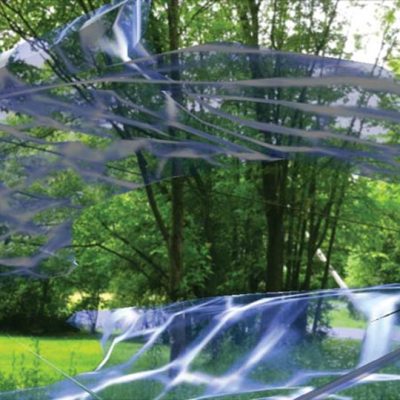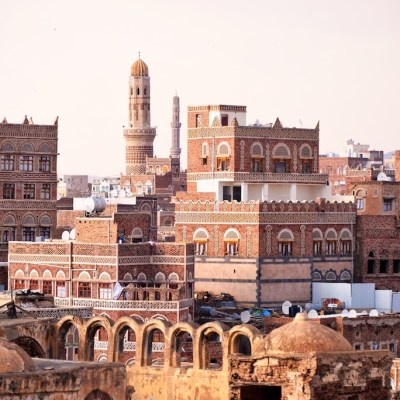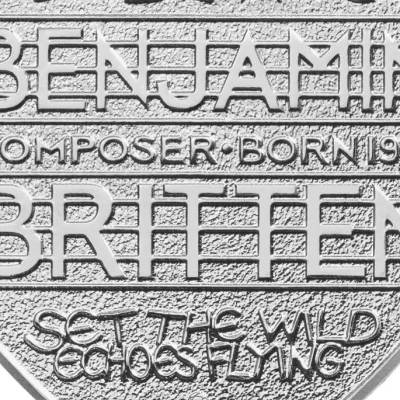Cornelia Parker has curated a wide-ranging group show that opens at the Foundling Museum this month. In the May issue of Apollo, she spoke to Imelda Barnard about creative collaborations, her obsession with found objects, and making art out of gin
How did the exhibition at the Foundling Museum come about?
Every two years the Foundling appoints three new fellows [an artist, a musician and a writer]. I’m the 2014 Hogarth Fellow, and this exhibition is the culmination of my two-year fellowship. The past visual art fellows have been Yinka Shonibare, Grayson Perry, and Richard Wentworth.
A selection of 18th-century tokens from the Foundling Museum collection. © The Foundling Museum
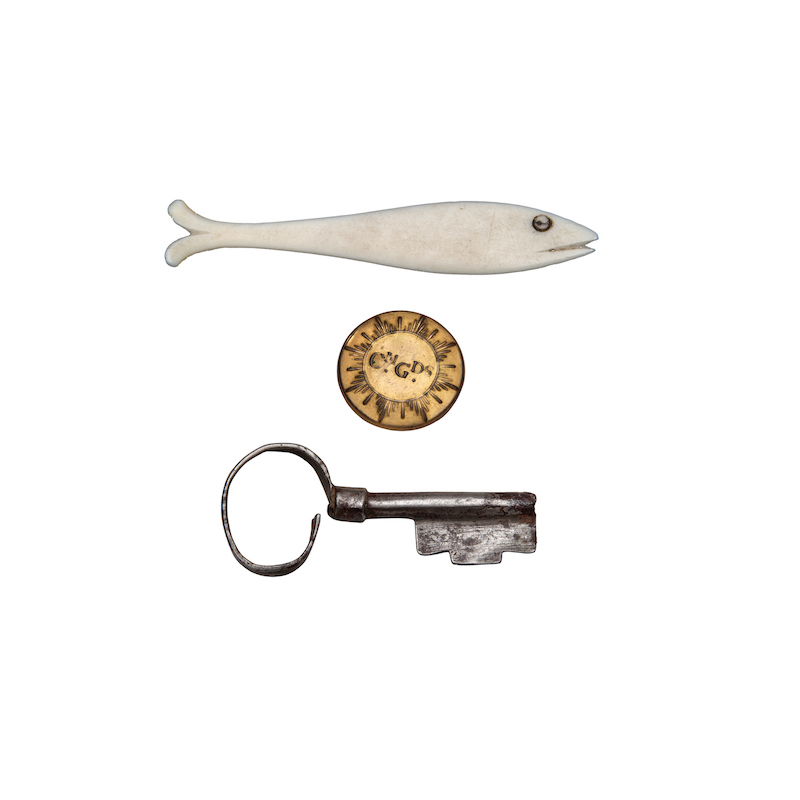
The exhibition is titled ‘Found’. How did you settle on the idea – and what aspects of the museum’s history struck you?
The Foundling Hospital has a collection of tokens – objects left by mothers with their relinquished babies, so they could identify their child if they ever came back to reclaim them. A kind of exchange happened; that object was the link between the parent and the child. It’s very poignant. So the exhibition revolves around the idea of the found, and by default the lost.
I didn’t want to make an exhibition focused on Foundling children because my own work doesn’t touch on that. But the found object is something I use a lot in my work, and it’s a preoccupation for many other artists too. In fact the whole idea of the found object is a 20th-century contribution to contemporary art. It’s been in my mind for a while to do a show about the idea, and this seemed a perfect opportunity – found at the Foundling.
The Foundling Museum. © The Foundling Museum

Were you inspired by the Foundling Hospital’s relationship with art in the 18th century, when it was established?
I wanted to curate a show with lots of artists because that’s what Hogarth did when he was a patron of the Foundling Hospital – he invited many of his fellow artists to exhibit there and it brought in crowds of people. This in turn contributed to the patronage of the Foundling Hospital by the great and good. So this exhibition follows a similar concept. The artists that Hogarth invited also marked the beginnings of the Royal Academy – the meetings and conversations that began here grew into the RA. I’ve invited over 20 Royal Academicians to be part of the show – the RA will return to the scene of the crime, the Foundling Museum! It’s also a chance to attract new audiences to the museum. Hopefully it will be quite a joyous, cacophonous experience.
What will the show look like? And what are some of the highlights?
It’s a very eclectic show – there are artists, writers, and musicians involved. John Smith is showing his film Dad’s Stick, which is about an object he found in his father’s shed after he died. It’s a stick that had been used to stir paint so it is covered in thick layers – and the stick will be in the show as well as the film. Graeme Miller has been obsessively collecting images off eBay, of things that look like faces – armchairs, appliances and so on. He’s also exhibiting a pack of 52 playing cards – a random set that he’s picked up off the street over the years. Alison Wilding is showing a petrified frog that she found in her cellar – it looks like it’s mid-jump; a very beautiful, enigmatic object.
The exhibition isn’t just about objects though – two of the works in the show revolve around finding a partner! Other works are about objects that artists have been inspired to write about: Marina Warner is writing about a whale tooth. The composer Jocelyn Pook, who’s also involved, uses found phrases and objects in her music.
This is a large group show that includes 50 artists in total. Were you conscious of wanting to curate something so broad?
Yes I was. I’m sure everybody has a found object, something they consider very personal to them. There’s a pattern emerging of shows I’ve curated involving lots of artists. I recently worked on an 13m-long embroidery piece, a copy of the Wikipedia entry of Magna Carta, for which I invited over 250 people to hand embroider sections. So I’m interested in that sort of crowdsourcing. I curated the RA’s black and white room in the 2014 Summer Exhibition – quite a lot of people involved in that show also feature in the Foundling one; and a few, such as Brian Eno, who worked on the Magna Carta piece, are in ‘Found’ too. It feels like an ever-growing team of people! In 2011 I also curated a display of 78 works at the Whitechapel Gallery drawn from the Government Art Collection. I like the idea of the exhibition becoming a cacophony of ideas.
Magna Carta (An Embroidery) (this panel stitched by Ann Carrick and Elaine Dunn), 2015, Cornelia Parker. Courtesy the British Museum, London
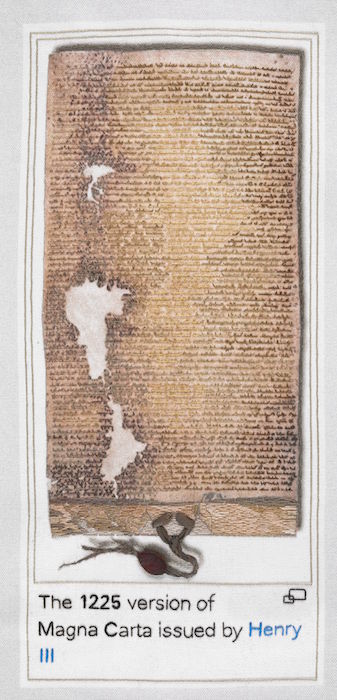
As an artist, does the experience of curating feel like a departure?
I think the two things are intertwined. I often curate groups of my own work made at different times in my life – I call them Avoided Objects. I might pair Embryo Firearms (1995) with Precipitated Gun (2015), a work where the gun is reduced to a pile of rust that is laid out like a line of cocaine. So two guns – one’s preemptive and the other has been precipitated in acid; both disarmed. I’m always curating little groups of works like this – the meanings change depending on what they’re paired with – so it just seems like a natural extension to include works by other artists. It’s quite an exhausting process but ultimately it’s very rewarding.
Have you been able to engage with the Foundling’s building and collection?
Yes. Luckily Caro [Howell], the Foundling’s director, is very up for me being an interventionist. There are going to be quite a few works of mine in the show. I’ve got all kinds of things I’ve collected over the years which I’m hoping to weave into the museum. Hopefully there will be evocative juxtapositions! I’m going to fill the temporary exhibition gallery, but the rest of the work will be dotted around the house. I want it to be a bit like a treasure hunt. It should encourage people to look differently at the Foundling’s own collection.
You’re also working on a site-specific installation for the Roof Garden of the Met in New York. What are your plans for this commission?
I can’t say too much at the moment but it’s something that will augment the view! It’s going to be architectural, a building of some kind. The Met’s roof is brilliant – from it you see Central Park surrounded by all those skyscrapers. I’m going to add something on the roof that will be read in terms of those two things.
Installation view of The Roof Garden Commission: Transitional Object (2016), Cornelia Parker. © Photographed by Alex Fradkin, Photo courtesy the artist
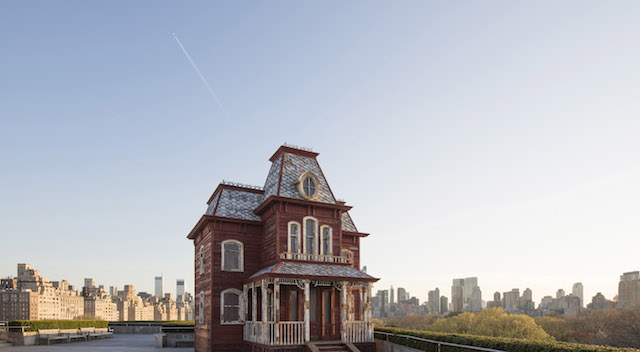
It’s hard to compete with a view of the New York skyline!
At the moment I’m competing with both the Foundling Museum and a big view in New York! The two projects are happening simultaneously; both wonderful but very different. The ‘Found’ show is more interior and intimate, whereas the piece in New York is very much about being on the roof in the summer with that amazing view. I’ve even designed a cocktail to go with it!
Actually, to accompany my show at the Foundling I’m making a limited-edition print to benefit the museum, based on gin. I’ve bought a gin glass from around the time of Hogarth – lots of his works feature people quaffing gin out of these little glasses, mothers even feeding it to their babies. Gin has had a lot to do with shaping the Foundling Hospital, of course – ‘mother’s ruin’.
I’ve recently been experimenting with photogravure and I think I’ve invented a new hybrid technique. So I’m hoping to make a print using spots of gin and the glass exposed on a photographic plate, so it looks like I’ve dropped gin on to the plate – it will be called something like A Few Drops of Gin! I’ve told the Foundling that if they were to have a cocktail it would have to be a gin-based one – ruin some more mothers!
‘Found’ is at the Foundling Museum, London, from 27 May–4 September.

